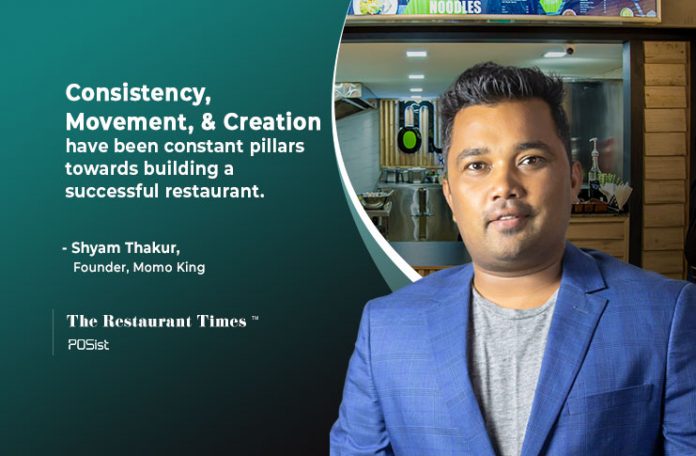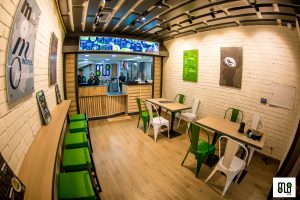Shyam Thakur is widely credited with playing a big role in spreading the authentic taste of Momo, originally a Nepali delicacy, across the Asian subcontinent through his F&B venture, Momo King. The entrepreneurial spirit subsisted in Shyam from a very young age. For Shyam, the candy shops were not mere shops to buy candies from. Those little shops got him thinking of the whole structure of setting up a business, instead of just being a consumer. He would wonder if he were to be at the other end, how he would do things differently. He finally entered the F&B industry officially in 2011 and life has never been the same for him since then!
In Conversation With Shyam Thakur of Momo King
In an exclusive conversation with The Restaurant Times, Shyam Thakur talks of his journey in the industry, the story behind Momo King, challenges faced while running the business, and a lot more.
Aim of the Momo King
Momo King is the ideal destination for foodies who want the real taste of Himalayan momos. Thakur says that the aim of the Momo King is divided into three simple parts: Product, People, Process. For the product part, their goal is to constantly strive to be the first to introduce and improvise the best of Himalayan dishes. Momo King was the first brand to introduce open momos. Secondly, customers are and have always been their focal point. Understanding changing palettes, the desire for more variety, and providing them with the best possible user experience with both food and service has been Momo King’s motto. Thirdly, the process has been optimized to increase efficiency. Since its inception, Momo King has always aimed for a centrally standardized process, which would help our brand with its scalability and maintaining consistency!
Challenges Faced in The Restaurant Business
The Momo King is headquartered in Kuala Lumpur. While mushrooming from Malaysia to India, he faced some challenges. Thakur believes that every country has two types of challenges – ones that are common in almost every country, and ones that are unique to each country. Those challenges are as follows:
- The Network of Vendors: Making connections with vendors is surely a daunting task. Partnering with a vendor is a big decision and there’s plenty to think about. It is essential to break down the various factors like financials, food safety, delivery, etc. When restaurants and vendors are in coordination, both businesses can thrive. It is up to the restaurateur to find vendors that are knowledgeable about the products they carry and that really have insights about the restaurant business and are aware of its functioning. Choosing quality vendors is the key to the success of your restaurant. The most economical vendor isn’t always the best one, so a restaurateur must check the quality of their food, and service record. In order to avoid poor vendor management, one must set standards before dealing with vendors which saves time and money spent. Not all vendors may perform as per your standards. In the absence of a vendor management system, storing and retrieving data might prove to be really tough, considering the fact that you may be dealing with multiple vendors for multiple projects at the same time.
- Standardization for Operations: By setting standards, your restaurant business can be more efficient and exceed customer expectations in many ways. Standardizing processes and recipes also assures guest satisfaction through consistent food and service. Return guests are generated when customers have a positive and consistent experience in the restaurant, including food and service. Standardization is one of the most crucial, yet overlooked ways of running a successful restaurant operation. By putting policies, procedures, operations manuals, recipe manuals, and training modules in place, you will encounter more positive customer and employee feedback, less employee attrition, and an all-around more successful venue says Thakur.
Menu Conceptualization
The culinary sphere as a whole is obsessed with finding the latest and most effective innovations. The menu surely drives purchasing and production decisions in all restaurant operations. Nowadays every restaurant is revising its restaurant menu list and improvising the cuisine selection. Thakur believes that the menu is the reflection of your brand. It’s the representation of exactly what you are selling.
At the Momo King, they have a very customer-centric approach to menu conceptualization. Continuing urbanization and changing spending behavior has also led to changing tastes and preferences of consumers in their eating habits.
Consumers are always keen on something new and trying new things, At Momo King, the staff experiment a lot in the kitchen. Like every other element of the service, experimenting should align with a brand’s overall identity. There is a core ‘taste team’ at the Momo King that continuously experiments by focusing on one ingredient at a time. It is surely a tedious task, but the team at Momo King is incredibly passionate about it!
Customer Engagement and Handling
Customer engagement involves any interactions that a customer may have with a restaurant brand and brand-focused interactions that a customer further has with his/her contacts. According to Thakur, customer engagement sits at the core of planning.
Everything that they do in between creating a great product and offering the best service, customer engagement is always a part. Their steps to customer engagement keep evolving every time there is a change in customer tastes and preference pattern, cultural or social influences, etc, that is thoroughly understood.
To offer a great customer experience, they naturally focus a lot on taste, hygiene, and quality. Equal attention, however, is also given to the service, the human experience, and the commitment to keep every single customer interaction both pleasant and professional. Customers appreciate professionalism more than one thinks they do. The key to fostering engagement is understanding your customers.
Thakur while concluding says that, Consistency, Movement, and Creation have been constant pillars towards building a successful restaurant. He believes that stagnation damages more brands than customers per se. Anything one does in their entrepreneurial journey, one thing that should always be a part of their strategy is to keep moving!



















